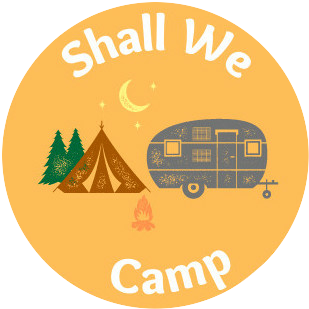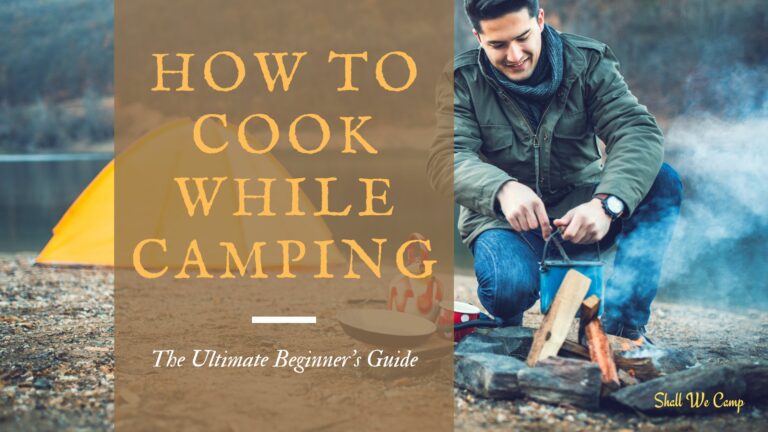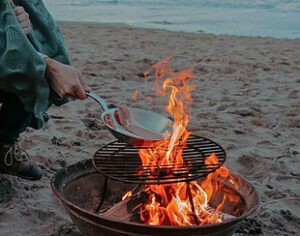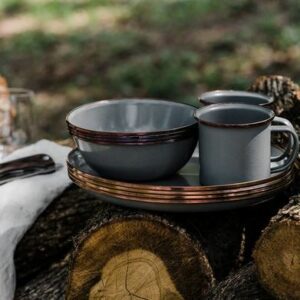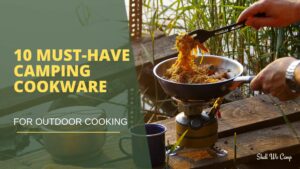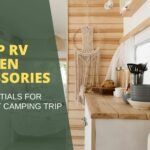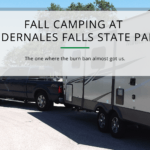There's nothing quite like the smell of pine trees, the crackle of a campfire, and the… growl of your empty stomach? Well maybe not the growl. Cooking in the wilderness is, in my opinion, downright fun. I enjoy it more than cooking at home.
In fact, 42% of campers say that learning to cook outdoors boosted their overall camping enjoyment!
So whether you're a city slicker venturing into the wild for the first time or a camping enthusiast looking to up your culinary game, this guide is your ticket to becoming the Gordon Ramsay of the campground (minus the yelling, of course).
Table of Contents
Essential Camping Cooking Gear: Your Outdoor Kitchen Checklist
When I first started camping, I had no clue what I was doing in the outdoor kitchen department. My first trip was a disaster – I forgot half the essentials and ended up eating cold beans straight from the can. Not exactly the gourmet wilderness experience I was hoping for! But over the years, I've learned a thing or two about what gear you really need to cook up a storm in the great outdoors.
First things first, you gotta have a reliable camp stove. I remember the time I thought I could get by with just a campfire – big mistake. It rained for three days straight, and I couldn't get a fire going to save my life. I've also been in situations where there is a burn ban in effect, so no campfires allowed. Now, I always pack a portable propane stove. They're lightweight, easy to use, and you can control the heat way better than with a campfire. Just don't forget extra fuel canisters – trust me, I've run out of gas in the middle of cooking breakfast a few times.
When it comes to cookware, you don't need to go overboard. A good quality pot, a frying pan, and a dutch oven will cover most of your bases. I swear by my cast iron skillet – it's like the Swiss Army knife of camp cooking. You can fry up some bacon and eggs for breakfast, then use it to bake a mean campfire cobbler for dessert. Just remember to season it properly, or you'll end up with a rusty mess.
Now, let's talk utensils. You might think you can get by with just a spoon and your trusty pocket knife, but trust me, you'll want a few more tools in your arsenal. A spatula, tongs, and a can opener are must-haves. And don't forget a good knife and small cutting board for chopping veggies and such.
When it comes to plates and cups, you've got two options: reusable or disposable. Personally, I'm a fan of reusable gear. It's better for the environment, and there's something satisfying about having your own camping mess kit. I personally love the Barebones Living plates and bowls. But if you're trying to save on weight or just don't want to deal with washing up, disposables can be a lifesaver. Just make sure you pack out all your trash.
Food storage is super important, especially if you're camping in bear country. A good cooler is worth its weight in gold – it'll keep your perishables fresh and your drinks cold. If you're backpacking or in an area with active wildlife, consider investing in a bear canister. They're a bit bulky, but they'll keep your food safe from critters and give you peace of mind.
Finally, let's talk about campfire cooking equipment. A grill grate is awesome for cooking directly over the fire, and a tripod can be handy for hanging pots. But my absolute favorite piece of gear is my pie iron. You can make the most amazing grilled sandwiches and pocket pies with that thing. It's like having a little panini press in the middle of the forest!
Remember, you don't need to buy everything at once. Start with the basics and build your outdoor kitchen over time. And don't be afraid to improvise – some of my best camping meals have come from getting creative with limited resources.
Setting Up Your Campsite Kitchen: Location, Safety, and Organization
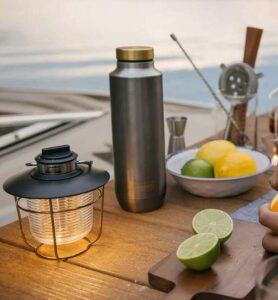
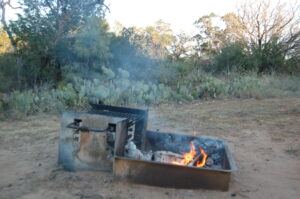
Setting up your campsite kitchen may seem like a pretty simple thing, but if done incorrectly you could end up with a smoky, bug infested tent or a raccoon raiding you food stash. And yes, that has happened to me while camping in Copper Breaks State Park.
COOKING LOCATION:
First, it's important to choose the perfect cooking spot. Setting up your stove right next to your tent might be convenient but it can attract insects and introduce them into your sleeping space. I always set up my kitchen area at least 100 feet away from my sleeping area. Look for a flat spot with some natural wind protection, but not too close to dense vegetation.
FIRE SAFETY:
Check the local regulations before you even think about striking a match. Some areas have fire bans during dry seasons, and you don't wanna be that guy who starts a forest fire. I always keep a bucket of water or sand nearby when I'm cooking over a fire. And definitely make sure your fire is completely out before you leave or go to sleep.
ORGANIZATION:
Creating a functional outdoor kitchen layout is kinda like playing Tetris with your gear. You want everything within reach, but not so cramped that you're tripping over your cooler every time you turn around. I like to set up my stove on a flat rock or a small folding table if I have one. Prep area goes on one side, clean-up station on the other. Also make sure your knife has a designated spot, or better yet, a cover or sheath. Getting a knife cut in the outdoors is never a good time.
WILDLIFE AND CRITTER CONTROL:
I've had my fair share of run-ins with hungry wildlife. One time, a family of raccoons raided my cooler and had a midnight feast with all my carefully packed meals. Luckily there was a small grocery store nearby, but that's not always the case. Always use proper food storage. If you're in bear country, use a bear canister or hang your food in a tree at least 10 feet off the ground and 4 feet from the trunk. In less wild areas, a locked cooler might do the trick, but never leave food out overnight.
LEAVE NO TRACE:
We want to keep our wilderness wild, right? Pack out everything you pack in. And I mean everything. Those apple cores and orange peels don't belong in the woods. I bring a couple of trash bags – one for actual trash and one for recyclables. And here's a pro tip: bring a few extra ziplock bags for wet or smelly trash. Your future self will thank you when you're not driving home with a car that smells like last night's fish dinner.
Campfire Cooking 101: Mastering the Basics
I've burned more than my fair share of hot dogs and ruined countless s'mores, but through trial and error (emphasis on the error), I've finally figured out how to tame the flame and cook up some pretty decent grub.
BUILDING THE FIRE:
When it comes to building that perfect cooking fire, I used to think bigger was better. I'll save you the suspense… I was wrong! These days, I aim for a more modest fire, about the size of a large pizza. Start with a good base of tinder (dry leaves, paper), add some kindling (small twigs or dryer lint), and then your larger fuel logs. And here's a pro tip: hardwoods like oak or maple burn longer and create better coals for cooking than softwoods like pine.
HEAT ZONES:
Once you've got your fire going, it's all about understanding those heat zones. Think of your campfire like a stovetop with different settings. The area directly over the flames is your high heat zone, perfect for boiling water or getting a quick sear on a steak. The edges of the fire where the coals are glowing is your medium heat, great for most of your cooking. And the area just outside the fire ring? That's your low heat zone, ideal for keeping things warm.
BASIC COOKING TECHNIQUES:
- Grilling is probably the easiest – just throw a grate over your fire and you're good to go.
- Boiling is great for pasta or coffee, just make sure your pot has a sturdy handle.
- Frying can be a bit tricky (I've definitely spilled my fair share of bacon grease into the fire), but it's doable with a good cast-iron skillet and some patience.
In addition to cast iron, a dutch oven is a game changer for campfire cooking. You can bake, braise, simmer and even make pizza in it! The key is to distribute the coals evenly, with more on top than bottom.
Foil packet cooking is my go-to method when I'm feeling lazy (which, let's be honest, is pretty often when I'm camping). Just wrap up your ingredients in heavy-duty foil, toss it on the coals, and voila! Dinner is served. The classic version of this is a mix of sliced potatoes, onions, and sausage with a pat of butter and some seasonings. The best part is that cleanup is a breeze!
Even when things don't turn out perfect, everything tastes better outdoors. So embrace the adventure, don't sweat the small stuff, and enjoy the process.
Camp Stove Cooking: When Fire Isn't an Option
Sometimes Mother Nature just doesn't want to cooperate and open campfires are just not an option. We camp mostly in Texas and during the dry season, we are constantly under fire bans. As a result, I have quickly I learned the value of a good camp stove.
Let's break down the types of camp stoves out there. You've got your classic propane stoves, which are great for car camping. They're reliable, easy to use, and you can control the heat pretty well. I've got an old Coleman two-burner that's been with me through thick and thin. Then there are the lightweight backpacking stoves that run on isobutane-propane canisters. These babies are perfect if you're trying to lighten your load on the trail.
There are also liquid fuel stoves that run on white gas. These are awesome for cold weather camping or high altitudes. And don't forget about the wood-burning stoves… they're eco-friendly and you don't have to carry fuel, but they can be a pain if all the wood is wet.
Always use your stove outside. I once heard about a guy who tried to use his camp stove in his tent. Spoiler alert: it didn't end well. Make sure you're on a level surface as well. I've knocked over more than one pot of boiling water on uneven ground. And keep flammable stuff away from your stove. Your nylon jacket might look cool, but it won't look so hot melted to your camp stove. Don't ask how I know that!
When it comes to camp stove cooking, one-pot meals are your best friend. They're easy, require minimal cleanup, and can be surprisingly delicious. Simply dump everything in the pot, heat it up, and bam – dinner's ready. Stir-fries are another great option. And don't underestimate the power of those pre-packaged rice or noodle sides. You can easily jazz them up with some canned chicken or tuna and you've got yourself a meal.
Finally, let's talk about fuel conservation. This is important because running out of fuel halfway through cooking your dinner is no fun. The key is to plan your meals ahead and prep as much as you can at home. Chop your veggies, pre-cook your meat if possible. Use a windscreen to protect your flame and improve efficiency.
Remember, cooking on a camp stove might not have the same romantic appeal as cooking over a campfire, but it's reliable, efficient, and can produce some pretty tasty meals. Plus, you're a lot less likely to smell like a bonfire for days afterward.
Meal Planning and Prep for Camping Success
I'm a big proponent of meal planning and prep. I'm naturally a planner so it comes easy for me. But honestly it can mean the difference between dining like an outdoor gourmet and choking down a granola bar to stave off hunger.
First thing you need to do is create a camping meal plan. I personally plan each meal, considering factors like how long the food will last, how easy it is to prepare, and whether I'll have access to a cooler. I like to mix it up as well… maybe some no-cook meals for lunch, one-pot dinners, and simple breakfasts to get the day started right.
I also prep ahead as much as I can. I chop veggies, pre-cook rice and pasta, and marinate meat before we leave home. I store everything in reusable containers or zip-lock bags. I even crack my eggs into a jar in order to keep them from breaking in transit.
Packing a cooler is an art form. Don't just throw everything in willy-nilly. You can pre-chill the cooler using blocks of ice or frozen water jugs. And then pack the most perishable items in the very bottom on the day you leave. Pro Tip: Fill any empty spaces with crumpled newspaper. It keeps things from shifting and helps maintain the cold.
For extended trips or when you can't bring a cooler, non-perishable foods are your best friend. Things like trail mix, jerky, dried fruits, and instant oatmeal or just add water meals. Canned goods are great too… tuna, beans, soups. Just don't forget the can opener. Trying to open a can of chili with a rock and a pocket knife is not a fun way to spend an evening.
Basically, the key is to plan ahead, prep what you can, and be willing to get creative. And always, always pack a few extra snacks. Nothing ruins a camping trip faster than a hangry camper.
Easy Camping Recipes for Beginners
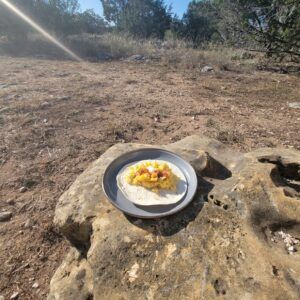
Even if you are a newbie to camping, there are some entry level camping recipes that can make your experience easy and enjoyable.
BREAKFAST:
This is arguable the most important meal of the day. Our personal favorite is a basic Campfire Breakfast Taco. I crack the eggs in a jar at home, add them to a hot skillet at camp, mix in some cheese and pre-cooked sausage. Then simply wrap it all up in a tortilla. If you master this easy breakfast, you can venture out and add things like hot sauce, sour cream, and cilantro.
LUNCH:
For lunch, I'm all about the no-cook options. You're usually in the middle of your adventure, and who wants to stop and fire up the stove? My favorite is what I call “Trail Tapas.” I pack a variety of snackable items like hard cheese, salami, crackers, nuts, and dried fruit. It's like a fancy charcuterie board, but in the middle of the woods!
DINNER:
One-pot meals are an easy option for dinners. My go-to is the “Camper's Chili Mac.” It's just a box of mac and cheese, a can of chili, and some extra cheese if you're feeling fancy. Cook the pasta, mix in the chili, top with cheese, and boom! Dinner's ready. Sometimes I'll add in a can of mushrooms or corn to beef it up a bit.
KID-FRIENDLY SNACKS:
If you're camping with kids, you've got to have snacks. Lots of snacks. When my boys were little, we used to have “Ants on a Log 2.0.” It's the classic celery with peanut butter, but we use chocolate chips for the ants and sprinkle some granola on top for extra crunch. It's got protein, it's got veggies, and it's got chocolate. Win-win-win!
DESSERTS:
Finally, let's talk desserts. Sure, s'mores are great, but let's think outside the graham cracker box. Have you ever tried a “Campfire Cone”? Take an ice cream cone, fill it with a mix of fruit and chocolate chips, wrap it in foil, and warm it over the fire. The chocolate melts, the fruit gets warm and gooey, and you've got a handheld campfire cobbler. I stumbled upon this recipe by accident when I forgot plates for our regular cobbler. Sometimes, the best recipes come from happy accidents!
Campsite Cooking Hacks and Tips
These are just a few of the camp cooking hacks that I've picked up throughout the years. Some of them you might have heard of, but hopefully there are a few new ones that you can utilize on your next camping trip.
SPICE IT UP:
I used to think salt and pepper were enough for camping trips. But after a week of bland meals, I realized the importance of a good spice kit. These days, I pre-mix my favorite spice blends at home and store them in small, airtight containers. My favorite is a mix of garlic powder, smoked paprika, and a bit of cayenne. It's amazing how a pinch of this stuff can transform a simple can of beans into a gourmet campfire meal.
MULTIPURPOSE COOKING TOOLS:
When I first started camping, I brought half my kitchen with me. My backpack looked like I was auditioning for a wilderness edition of MasterChef! So now I'm all about tools that can do double (or triple) duty. A large pot can be a mixing bowl, a wash basin, and a bear-proof food storage container. A plastic spatula can stir your chili, flip your pancakes, and even serve as a makeshift knife in a pinch.
CLEAN UP:
The less glamorous side of camp cooking is the clean up process. We want to leave our campsites better than we found them, right? One trick I've learned is to use a little bit of biodegradable soap and sand to scrub your pots. It works like a charm and doesn't require much water. And here's a great tip: heat some water in your pot right after cooking, while it's still warm. It'll make cleaning so much easier.
ADAPTABLE MEALS:
For me, adapting home recipes for campfire cooking is where the real fun begins! It lets me get creative and use ingredients I'm already used to working with. Almost any recipe can be campfire-friendly with a little creativity. That lasagna you love? Layer it in a Dutch oven and cook it over the fire. Your favorite stir-fry? Prep the ingredients at home and cook them in a cast-iron skillet over the campfire. I once even managed to make a pretty decent pizza using foil as the “oven”.
Camping cuisine is all about adaptability and creativity. Some of my best camp meals have come from happy accidents or last-minute improvisations.
The most important thing is to have fun with it. Embrace the challenges, laugh at the mishaps, and savor every bite. There's something magical about a meal cooked over a campfire, even if it's just a slightly charred hot dog.
Special Dietary Considerations While Camping
VEGETARIAN & VEGAN:
Now, I'm not a vegetarian myself, but I've camped with plenty of plant-based pals over the years. One of my favorite go-to meals is what I call the “Campfire Veggie Burrito Bowl.” It's simple: pre-cook some rice at home, bring along some canned black beans, corn, and your favorite salsa. Heat it all up in a pot, and You've got a hearty, protein-packed meal that'll satisfy even the most ardent carnivore. And hey, if you're feeling fancy, throw in some pre-chopped bell peppers and onions for extra flavor and nutrition.
GLUTEN FREE:
Now, for the gluten-free campers out there, I feel your pain. I once watched a celiac friend sadly munch on plain rice while the rest of us gorged on s'mores. Never again! Corn tortillas are great for wraps and quesadillas. Quinoa makes an excellent base for one-pot meals… just cook it in veggie broth for extra flavor. And don't forget about foil-packet meals! Wrap up some potatoes, veggies, and your protein of choice in foil, toss it on the fire, and you've got a delicious, gluten-free dinner with minimal cleanup.
FOOD ALLERGIES:
Dealing with food allergies while camping can be tricky, but it's not impossible. The key is preparation and communication. If you're camping with a group, make sure everyone knows about any allergies beforehand. I try to always pack allergy-friendly snacks like fruit leather, seeds, and safe energy bars. And remember, when in doubt, leave it out. It's better to have a slightly less exciting meal than an exciting trip to the ER.
ENERGY-PACKED MEALS:
For high-energy hikers and adventure seekers, let's talk about meals that'll keep you going all day long. I'm a big fan of overnight oats for breakfast. Mix oats, milk (or a non-dairy alternative), chia seeds, and some dried fruit in a container before bed, and you'll wake up to a protein-packed, energy-dense breakfast. For lunch on the trail, I swear by my “Power Wraps.” Spread some hummus on a tortilla, add some pre-cooked quinoa, sundried tomatoes, and a handful of spinach. Roll it up and you've got a portable powerhouse of a meal.
From Campfire Novice to Outdoor Chef: Your Culinary Adventure Begins!
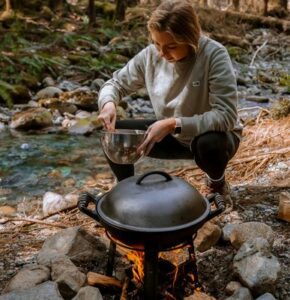
Hopefully this guide has taught you how to cook easy meals while camping and also given you some valuable tips that you can incorporate on your next camping adventure. Cooking while camping is all about embracing simplicity, getting creative, and most importantly, having fun! Don't be afraid to experiment, but always prioritize safety and respect for nature.
With the tips, tricks, and recipes you've learned, you're ready to transform any camping trip into a delicious adventure. So pack your gear, gather your ingredients, and get ready to create meals and memories that'll have you yearning for your next outdoor escapade.
Happy camping and bon appétit!
